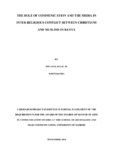| dc.description.abstract | This study set out to investigate the critical role that religious leaders and the media play in
bringing about or exacerbating religious tensions and conflict in Kenya. In particular, the
study sought to establish what role communication plays in creating animosity and in
fomenting conflict between followers of the two major faiths in Kenya – Christianity and
Islam. The role of spiritual leaders from the Christian and Muslim traditions in the conflict,
and how the slanting of media reports on religious issues affects perceptions that could either
stem down or raise religious tensions. The study based itself on the Two-Step Flow Theory of
Paul Lazarsfeld and his colleagues, which basically states that opinions expressed in the mass
media are first synthesized by opinion leaders, who then influence the rest of the people.
Within the context of this study, Christian and Muslim religious leaders would be the critical
opinion shapers who influence perceptions of their followers regarding other faiths,
consequently determining whether adherents of these two religions live together in peace or
not. The findings of the study indicate that materials intended for mass consumption
addressing the issue of inter-religious tolerance are few and far between. Regular newspapers
do not tackle this sensitive societal issue with the same level of seriousness accorded less
dangerous territory such as sports or travel. Reporting on religious issues is also heavily
slanted in favour of Christians, and does not portray the level of knowledge and sensitivity
required of such an important coverage. While religious groups have been holding interreligious
dialogue for years, the study found that more needs to be done if rising interreligious
violence is to be nipped in the bud. Religious leaders, the study found, generally
have a strong influence on their followers, and it is important that those involved in
campaigns for peace between Christians and Muslims should be more focused if they are to
counterbalance their more radical counterparts. Arising from this study, it is recommended
that current efforts at inter-religious dialogue need to be strengthened in order to counter the
rising tide of inter-religious conflict and the negative influence of some radical spiritual
leaders. Moreover, media houses will need to re-examine and strengthen the reporting of
religious issues in order to overcome the many weaknesses pointed out in this study. These
recommendations will help Kenya to avoid sliding down the path of serious religious
confrontation between Christians and Muslims, a danger that the country has so far avoided
despite the lack of a clear strategy and focus. | en_US |

